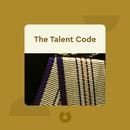The Talent Code
The Talent Code: Greatness Isn’t Born. It’s Grown. Here’s How.
Your highlights:Deep practice consists of "chunking up" the task, i.e., repeating it and looking for difficulties.
Second, deep practice requires time, since increasing a particular skill demands a lot of repetition. The more we repeat a task, the more precise and quick the action will become, because the myelin layer surrounding the relevant circuit thickens. Third, engaging in deep practice means making things a little difficult for yourself while practicing. Because repeating something you already know inside out doesn’t improve your skill. Instead, you must always practice just beyond the limits of your ability.
5 September, 2019 02:56 Share
We need an external cue – ignition – to motivate us to develop a skill over the long term.
While we might believe that a person’s talent must’ve stemmed from their innate interest in their skill early on in life, usually, their initial motivation to acquire that skill was triggered by some external force. As we’ve seen, to become skilled at something, we need to engage in deep practice. Because this practice is very difficult, it requires us to be extremely motivated to improve. One such motivator is ignition, an external cue that triggers our desire to become skilled at something, and convinces us that it’s possible to achieve if we work hard for it.
5 September, 2019 02:56 Share
Some types of coaches serve ignition and some serve deep practice.
One study has shown that many talented people (especially pianists, tennis players and swimmers) had just average coaches in their early years. While this might seem unusual, it makes sense. For example, if you’re learning to play piano as a child, you need – above all – motivation to keep practicing hard. While a teacher who focuses on deep practice can be effective for already skilled and motivated players, beginners would do better with, say, a friendly teacher who makes them feel good about themselves, rewards them with treats for working hard, and encourages them to learn their favorite songs. This type of approach is far more likely to ignite a person’s motivation in their early years.
5 September, 2019 02:58 Share
Master coaches need a vast knowledge of their field and the ability to meet the individual needs of their students.
A master coach – that is, one who can successfully connect deep practice and ignition – must connect their technical knowledge with the needs of the individual student. The goal of all coaches is to assist the student in reaching a state of deep practice, yet every student is unique and requires an equally specific coaching style.
5 September, 2019 02:58 Share
In his research, the author noticed that most coaches didn’t yell or even talk very much, but rather provided simple, precise instructions, e.g., "adjust that movement" or "try this instead." Clarity of information is crucial to deep practice because, by following such instructions, the students’ nerves are fired, thickening the myelin layer and thus strengthening the circuits involved in executing the skill. Without such clear and precise instructions, any technical knowledge a coach has can’t be translated into concrete results. Just as the instructions of a physical trainer must be clear for their knowledge to lead to you building stronger muscles, coaches in any given field must be clear and precise in their directions in order for their technical knowledge to result in your myelin growth.
5 September, 2019 02:58 Share
About the book:
The Talent Code uses recent neurological findings to explain how talent can be trained through deep practice. It shows how nurturing our cellular insulation – called myelin – influences the development of our skills, and explains why certain methods of practice and coaching have been used in "talent hotbeds" around the world to great success.
About the author:
Daniel Coyle is the bestselling author of books including the award-winning Lance Armstrong: Tour de Force and The Secret Race: InsidetheHiddenWorldoftheTourdeFrance. He’s also a regular contributor to magazines such as the New York Times Magazine and Sports Illustrated, and a contributing editor to Outside magazine.
Blinkist takes outstanding nonfiction books and distills their key insights into made-for-mobile book summaries that you can read in just 15 minutes. Learn something new every day - on your smartphone, tablet or PC.
blinkist.com